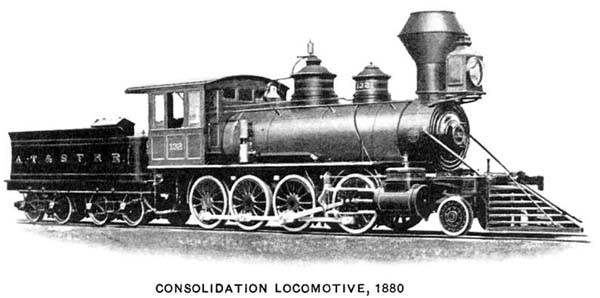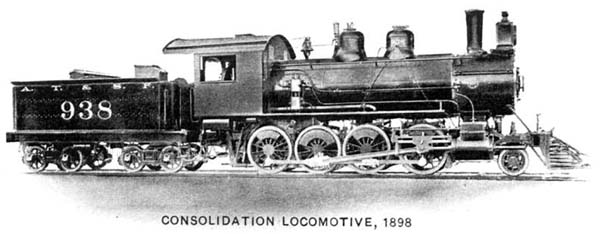|
During the years 1880 and 1881, forty-five Consolidation locomotives, built at the Baldwin Works, were added to the equipment. Fourteen of these engines were similar in many respects to the "Uncle Dick," having the same wheel spacing and the same size boiler. The saddle tank was omitted; the diameter of the driving wheels was increased to fifty inches, and the piston stroke to twenty-eight inches. The total weight was 107,000 pounds, the weight on driving wheels being 91,800 pounds. The tank capacity was 3200 gallons. Engine No. 132, illustrated on page 8 {below},
represents the class. The remaining thirty-one Consolidation locomotives referred to were built for the Rio Grande, Mexico and Pacific Division. They were lighter engines having cylinders seventeen inches in diameter by twenty-six inches stroke; the driving wheels being forty-five inches in diameter. The total weight was about 79,000 pounds of which the driving wheels carried about 66,000 pounds. In 1882, fifteen American type locomotives were built, these being the heaviest engines of this type so far delivered to the road. Their weight being about 78,000 pounds. During the next few years, the necessity for heavier locomotives for passenger traffic became fully realized; and in 1886 the Baldwin Works began the building of ten-wheel engines for this class of service. These were large locomotives for their day, having cylinders nineteen inches in diameter by twenty-six inches stroke and fifty-eight inch driving wheels. The boiler was straight, sixty inches in diameter. It contained 227 tubes, two and one-quarter inches in diameter, and thirteen feet one and one-half inches long. The firebox measured eighty-two and fifteen-sixteenths inches long and thirty-four and three-eighths inches wide, the grate area being twenty square feet. The firebox heating surface was 143 square feet, and the tube heating surface 1742 square feet; thus giving a total of 188S square feet. The driving wheels were grouped on a wheelbase of fourteen feet six inches, the total wheelbase being twenty-five feet eleven and one-half inches. These engines weighed 114,500 pounds in working order, the weight on driving wheels being 85,400 pounds. The tank capacity was 3500 gallons. During the ten years following 1886, upward of 100 ten-wheel locomotives, for both passenger and freight service, were supplied to the System, in addition to a number of six-wheel switchers and a few eight-wheel and Consolidation engines. During this period steam pressures gradually increased from 130 and 140 pounds to 180 pounds, and in 1894 several eight-wheel and ten-wheel engines were built to work at 200 pounds, an unusually high pressure for single-expansion engines at that time. The demand for more powerful locomotives was being met, and forty-five Consolidation engines built in 1898 were representative of the type then employed for heavy freight service. One of these engines is illustrated on page 9 (below). Particular interest attaches to this design, as these were the first locomotives built by the Baldwin Works to have cast steel frames, which had largely been used by John Player, then Superintendent of Motive Power, and which were specified by him. The builders guaranteed to replace, within a period of two years, all frames showing defective material or workmanship, provided such frames were made by the Standard Steel Works. Frames furnished by other makers and accepted by the company's representative, were not subject to the guarantee. The cylinders of these engines were twenty-one inches in diameter by twenty-eight inches. stroke, the driving wheels being fifty-seven inches in diameter. The boiler contained 1905 square feet of heating surface and twenty-nine and one-quarter square feet of grate area, and carried a steam pressure of 180 pounds. The total weight in working order was 156,130 pounds, of which 139,530 were carried on the driving wheels. These engines were followed, in 1900, by forty heavier locomotives of the same type, having larger boilers and thirty-inch piston stroke. |









